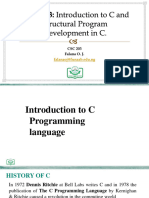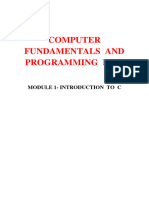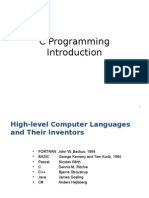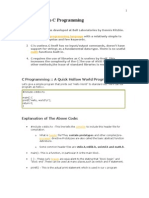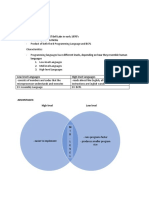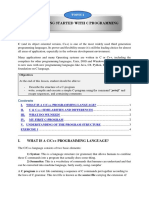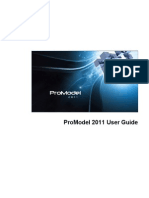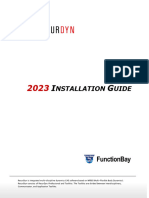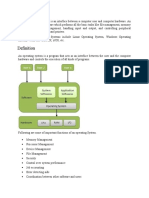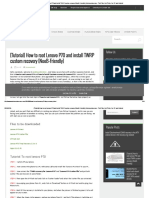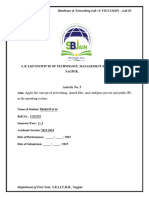Introduction to C/C++
Programming
Dr Zulkefli Bin Mansor
28 Sept 2015
About Myself
Name: Dr Zulkefli Bin Mansor
E-mail: kefflee@gmail.com or kefflee@ukm.edu.my
Phone: +60193937795
Room: No room at UPNM
Website: www.kefflee.net
Anything else? Ask me….
Let’s introduce yourself
Name
Nick name
Program
Hometown
Anything
What is a program
A sequence of instructions that a computer can
interpret and execute;
If I tell you the way from UKM to UPNM… I will tell
sequence of instructions…. Any wrong instruction
leads to a undesired result.
A program is something that runs on your
computer. In case of MS Windows program is of
.EXE or .COM extensions
MS Word, Power point, Excel are all computer
programs
Why we need programming
language?
Writing machine language code is very difficult if not
impossible
Standard manner to type instructions on computers
Why standard? << Any comments >>
If there was no such standard then everyone would have to
write his/her own compiler…. Or use machine language
On problem with using machine language is the machine
language expert of one machine cannot be an expert of
other machine as both machines might have totally different
architectures and calls
Another use is that makers of programming language often
supply us with pre-built functions that help us save time (hence
money )
Evolution of programming languages
The lack of portability between different computers led to the
development of high-level languages—so called because they permitted
a programmer to ignore many low-level details of the computer's
hardware
Details of procedural, non-procedural will follow in the lectures.
How people used to program ?
Machine Language….. Damn! It was difficult
Assembly Language…. Use keyword.
Required too much user involvement
To much to remember
C Language
B Language.. Bell Labs
Improved to C Language
Is a compiled language
Writing C Programs
A programmer uses a text editor to create or
modify files containing C code.
Code is also known as source code.
A file containing source code is called a source
file.
After a C source file has been created, the
programmer must invoke the C compiler before
the program can be executed (run).
Compiler converts
human readable
language to a language
which is
understandable by the
operating
system/hardware
Examples of
C/C++ compilers
of today:
Visual C++
GCC/G++
DJGPP (open source
for windows like
GCC)
Borland C
Turbo (obsolete and
not recommended)
3 Stages of Compilation
Stage 1: Preprocessing
Performed by a program called the preprocessor
Modifies the source code (in RAM) according to
preprocessor directives (preprocessor commands)
embedded in the source code
Strips comments and white space from the code
The source code as stored on disk is not modified.
3 Stages of Compilation (con’t)
Stage 2: Compilation
o Performed by a program called the compiler
o Translates the preprocessor-modified source code into
object code (machine code)
o Checks for syntax errors and warnings
o Saves the object code to a disk file, if instructed to do so (we
will not do this).
o If any compiler errors are received, no object code file will be
generated.
o An object code file will be generated if only warnings, not errors,
are received.
3 Stages of Compilation (con’t)
Stage 3: Linking
o Combines the program object code with other object code
to produce the executable file.
o The other object code can come from the Run-Time Library,
other libraries, or object files that you have created.
o Saves the executable code to a disk file. On the Linux
system, that file is called a.out.
o If any linker errors are received, no executable file will be
generated.
Program Development Using gcc
Editor
Source File pgm.c
Preprocessor
Modified Source Code in RAM
Compiler
Program Object Code File pgm.o
Other Object Code Files (if any)
Linker
Executable File a.out
A Simple C Program
#include <stdio.h> //This is preprosessor directive
int main ( void ) //this tells the starting point of your
program
{
cout << “Hello World” <<endl ; //print the text on
monitor
return 0 ; //return to operating system
}
Note: cout is an object given to you by the creators of C++. This function saves you
From the complexity of writing your own function of how to display text on the computer
Screen. Hence you are more productive with the actual program rather than worrying
About such issues.
Anatomy of a C Program
program header comment
preprocessor directives (if any)
int main ( )
{
statement(s)
return 0 ;
}
Program Header Comment
A comment is descriptive text used to help a reader of
the program understand its content.
All comments must begin with the characters /* and
end with the characters */
These are called comment delimiters
The program header comment always comes first.
Look at the class web page for the required contents of
our header comment.
Preprocessor Directives
Lines that begin with a # in column 1 are called
preprocessor directives (commands).
Example: the #include <stdio.h> directive
causes the preprocessor to include a copy of
the standard input/output header file stdio.h at
this point in the code.
This header file was included because it
contains information about the printf ( ) function
that is used in this program.
stdio.h
When we write our programs, there are
libraries of functions to help us so that we do
not have to write the same code over and
over.
Some of the functions are very complex and
long. Not having to write them ourselves make
it easier and faster to write programs.
Using the functions will also make it easier to
learn to program!
int main ( void )
Every program must have a function called main.
This is where program execution begins.
main() is placed in the source code file as the first
function for readability.
The reserved word “int” indicates that main()
returns an integer value.
The parentheses following the reserved word
“main” indicate that it is a function.
The reserved word “void” means nothing is there.
The Function Body
A left brace (curly bracket) -- { -- begins the
body of every function. A corresponding right
brace -- } -- ends the function body.
The style is to place these braces on separate
lines in column 1 and to indent the entire
function body 3 to 5 spaces.
Cout << “Hello, World!” <<endl ;
This line is a C++ statement.
It is a call to an object with a single argument
(parameter),
Even though a string may contain many characters,
the string itself should be thought of as a single
quantity.
Notice that this line ends with a semicolon. All
statements in C/C++ end with a semicolon.
return 0 ;
Because function main() returns an integer value,
there must be a statement that indicates what this
value is.
The statement
return 0 ;
indicates that main() returns a value of zero to
the operating system.
A value of 0 indicates that the program successfully
terminated execution.
Do not worry about this concept now. Just
remember to use the statement.
Another C Program
/*****************************************
** File: proj1.c
** Author: Kefflee
** Date: 28/9/2015
** SSN: 123-45-6789
** Section: 0304
** E-mail: kefflee@upnm.edu.my
**
** This program prompts the user for two integer values then displays
** their product.
**
***********************************************/
Another C Program (con’t)
#include <stdio.h>
int main( void )
{
int value1, value2, product ;
printf(“Enter two integer values: “) ;
scanf(“%d%d”, &value1, &value2) ;
product = value1 * value2 ;
printf(“Product = %d\n”, product) ;
return 0 ;
}
Tokens
The smallest element in the C language is the
token.
It may be a single character or a sequence
of characters to form a single item.
Tokens are:
Tokens can be:
Numeric constants
Character constants
String constants
Keywords
Names (identifiers)
Punctuation
Operators
Numeric Constants
Numeric constants are an uninterrupted sequence of
digits (and may contain a period). They never
contain a comma.
Examples:
123
98.6
1000000
Character Constants
Singular!
One character defined character set.
Surrounded on the single quotation mark.
Examples:
‘A’
‘a’
‘$’
‘4’
String Constants
A sequence characters surrounded by double quotation marks.
Considered a single item.
Examples:
“UMBC”
“I like ice cream.”
“123”
“CAR”
“car”
Keywords
Sometimes called reserved words.
Are defined as a part of the C language.
Can not be used for anything else!
Examples:
int
while
for
Names
Sometimes called identifiers.
Can be of anything length, but on the first 31 are significant
(too long is as bad as too short).
Are case sensitive:
abc is different from ABC
Must begin with a letter and the rest can be letters, digits, and
underscores.
Must follow the standards for this course!
Punctuation
Semicolons, colons, commas, apostrophes,
quotation marks, braces, brackets, and parentheses.
; : , ‘ “ [ ] { } ( )
Operators
There are operators for:
assignments
mathematical operations
relational operations
Boolean operations
bitwise operations
shifting values
calling functions
subscripting
obtaining the size of an object
obtaining the address of an object
referencing an object through its address
choosing between alternate subexpressions









